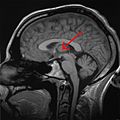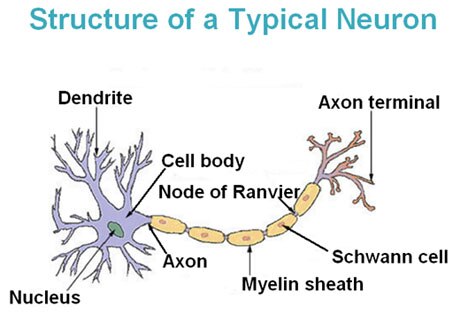AY Honors/Brain and Behavior/Answer Key
Brain and Behavior
1. Be able to label a diagram or a model of a human brain including the following parts and tell briefly what each part does:
- Medulla oblongata.jpg
Medula
- Midbrain.jpg
Midbrain
- Cerebrum.jpg
Cerebrum
Medulla
The medulla controls the autonomic functions such as breathing, and heartbeat. These are things a person does not need to think about but which happen without concious effort.
Pons
The pons is a knob on the brain stem. It is part of the autonomic nervous system, and relays sensory information between the cerebellum and cerebrum.
Cerebellum
The cerebellum plays an important role in the integration of sensory perception and motor output.
Midbrain
Thalamus
The thalamus can be thought of as a relay station for nerve impulses carrying sensory information into the brain. It receives these sensory inputs as well as inputs from other parts of the brain and determines which of these signals to forward to the cerebral cortex.
Hypothalamus
The hypothalamus links the nervous system to the endocrine system by stimulating the secretion of hormones from the pituitary gland.
Pituitary gland
The pituitary gland secretes hormones regulating a wide variety of bodily activities, including hormones that stimulate other endocrine glands.
Cerebrum
The cerebrum is where thinking occurs. This is the area of the brain responsible for language, memory, and emotion, as well as motor control and the sense of smell.
2. What is a neuron? Draw a picture of a typical neuron and label its parts. Where does information enter a neuron and where does information leave from?
Neurons (also called nerve cells) are a major class of cells in the nervous system. In vertebrates, they are found in the brain, the spinal cord and elsewhere in the nervous system. Their primary role is to process and transmit neural information. One important characteristic of neurons is that they can generate and propagate electrical signals.
Neurons are discrete cells which communicate with each other via specialized junctions. Information enters the neuron primarily through the dendrites and exits through the axon.
Neurons communicate with one another and to other cells through synapses, where the axon terminal of one cell connects to a dendrite of another.
3. Explain how drugs affect the function of neurons especially at the 'synapse'. Make a commitment never to take drugs except for medical reasons.
Axons carry electrical signals from a neuron to the dendrite of another neuron. However, an axon cannot transmit these electrical signals directly to a dendrite - it needs a synapse to do this. The synapse converts the electrical impulse to a chemical reaction, which releases different types of chemicals called neurotransmitters. These neurotransmitters travel across the synapse and cause other chemical reactions which generate electricity in the dendrite.
The synapses can be "trained" to react strongly, weakly, anywhere in between, or not at all. It is because they can adapt that we are able to learn new things, form habits (good or bad), or suffer from addictions.
Many drugs affect the way the synapse does its job by preventing the neurotransmitter chemicals from travelling across the synapse. Drugs can also amplify these reactions, so that they are more intense than they would have been in the absense of the drug.
4. What is a reflex? Perform a knee-jerk reflex test on someone. Explain why it occurs (use the following terms in your answer: sensory neuron, motor neuron, spinal cord). Why do doctors use this test in a physical exam?
Instructions: Gently tap someone just below the knee-cap while the person's leg is hanging over the edge of a chair.
A simple reflex is entirely automatic and involves no learning. An example is the escape reflex (e.g., the sudden withdrawal of a hand in response to a pain stimulus), or the patellar reflex (the jerking of a leg when the kneecap is tapped). Sensory neurons in the stimulated body part sends a signal to the spinal cord. Within the spinal cord a reflex arc switches the signal straight back to the muscles of the body (in this case the arm or the leg) to a motor neuron; contraction of the muscle occurs (the arm or leg jerks upwards). Only three nerve cells are involved, and the brain is only aware of the response after it has taken place.
The deep tendon reflexes provide information on how well of the central and peripheral nervous systems are working. Generally, decreased reflexes indicate a problem in the peripheral nervous system. Lively or exaggerated reflexes indicate a prolbem in the central nervous system.
5. What is a sensory neuron, and what is "adaption".
Sensory neurons are nerve cells within the nervous system responsible for converting external stimuli from the organism's environment into internal electrical impulses. For example, some sensory neurons respond to tactile stimuli and can activate motor neurons in order to achieve muscle contraction. Such connections between sensory and motor neurons underlie motor reflex loops and several forms of involuntary behavior, including pain avoidance. In humans, such reflex circuits are commonly located in the spinal cord.
Neural adaptation is a change over time in the responsiveness of the sensory system to a constant stimulus. It is usually experienced as a change in the stimulus. For example, if you rest your hand on a table, you immediately feel the table's surface on your skin. Within a few seconds, however, you cease to feel the table's surface. The sensory neurons stimulated by the table's surface respond immediately, but then respond less and less until they may not respond at all; this is neural adaptation.
Demonstrate adaption by doing the following: Rest your arm on a table and then place a small cork (or something very light) on your arm.
Notice how it feels at that time and how it feels one minute later after not moving.
Place one finger of one hand in a bowl of cool water and another finger of the other hand into a bowl of warm water.
After 30 seconds, put both fingers in to a bowl of water at room temperature. How does the water at room temperature feel on each finger?
What spiritual lesson can be drawn from the concept of adaption?
Just as the sensory system can adapt to a stimulus until it no longer even notices it, we can adapt to a sinful environment until we no longer notice the sin. The conscience becomes numbed when ignored. We must be careful about the sorts of stimuli we allow ourselves to be subject to. Watching television programs that promote sin will dull our senses to the enormous evil of sin just as a constant stimulus to the skin will dull our perception to it.
6. How are the senses of taste and smell similar and how are they different.
Draw a map of which part of the tongue responds to the following tastes: sweet, sour, bitter, salt. Instructions: Have someone dip a Q-tip into one of the following: sugar water (for sweet), lemon juice (for sour), flat tonic water (bitter) or salty water (salt), and then lightly touch different parts of your tongue. Notice which areas of the tongue taste the solution that is being tested. Rinse with pure water between each test and use a new Q-tip for each test.
7. Draw a picture of the various parts of the eye and explain why you have a blind-spot. Find your blind-spot for one eye.
Instructions: Place a very small black dot on the center of a white piece of paper. Close one eye and stare directly ahead. Hold the paper at arms length in front of you and move the paper until the spot "disappears" (usually this is occurs when the dot is just a bit below eye level - it is important).






